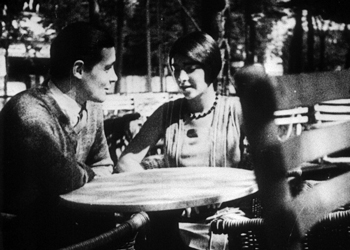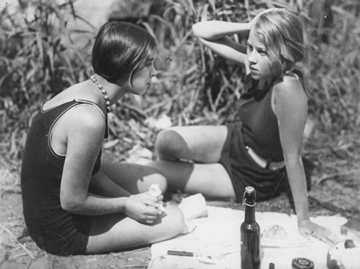
 |
|
|
|
In 1929 a small group of film-minded Berliners sat around tables at the Romanisches Cafe hatching plans to make movies, just as do today's film and art school students. Billy (Billie) Wilder, Robert and Kurt (Curt) Siodmak, Fred Zinnemann and Edgar J. Ulmer had varying contact with the busy German film industry but between them few solid credits. Only young art director Edgar J. Ulmer had a real track record, having worked in Hollywood helping F. W. Murnau on his artistic epic Sunrise. Enlisting veteran cameraman Eugen Schüfftan, the special effects whiz from Metropolis, the group began filming with some money from the Siodmak's Uncle Heinrich Nebenzal; a Murnau assistant Rochus Gliese is set to direct. 
People on Sunday (Menschen am Sonntag) was conceived as an attention-getting alternative movie concept made by a skeleton crew without studio resources. Based roughly on the poetic documentary concept seen in celebrated silent "City Symphony" films, its idea is to show everyday life in Berlin for what it is, with actors who play themselves instead of performing roles. The young filmmakers shoot on the streets and in public spaces. Although most of the partners take a hand in all production roles, Robert Siodmak and Edgar Ulmer become the credited directors after Gliese drops out. Billie Wilder and Kurt Siodmak split an odd writing credit: "script by" and "from a reportage by". Fred Zinnemann accepts the least visible position as Schüfftan's camera assistant. People on Sunday takes the cake as the most successful audition film ever -- a full five of its first-time partners became world famous Hollywood film directors. The movie remains a fascinating and insightful classic, a naturalistic look at what a quartet of young Berliners might do with their day off. Erwin (Erwin Splettstößer) is a taxi driver and Wolfgang (Wolfgang von Waltershausen) is a busy wine seller. Neither has much disposable income so their idea of a Sunday outing is to find some willing girl and join the mob of Berliners heading out by streetcar to the Wannsee lake and recreation area. Wolfgang picks up Brigitte (Brigitte Borchert) when a date stands her up on a street corner. The scene is filmed mostly in wide shots showing Wolfgang circling his prospective pickup on a traffic island in the middle of real-life Berlin activity. That's the key aesthetic working in People on Sunday -- its little drama plays out against an authentic background. The editing often drifts into montages of 'random' holiday activities at the Wannsee beaches, boardwalks and amusement areas. For a story we get a pair of flirtations, some hurt feelings and a change of partners. One amusing narrative surprise comes early on, when the expected hot date Annie, an attractive model (Annie Schreyer), sleeps in and fails to show up. But no matter, Brigitte has brought a friend for company, Christl (Christl Ehlers). 
People on Sunday is interesting now for the same reason that Berlin moviegoers found it fascinating in 1930: compared to ordinary movies, this one looks like a snapshot of real life. We see real streets, real advertising signs and note the petty details of checking out a paddle boat, or winding up a borrowed phonograph to have some music for a sit-down in a secluded park area. Wolfgang entertains Brigitte with silly little activities that haven't changed, like dropping water on a scrunched-up straw wrapper and watching it grow like a living worm. The writing is smart, avoiding artificial gags but finding business that reads as "natural". Much of the film is spent reading the faces of the non-actors, who seem comfortable in their roles. Viewers accustomed to European movies of the time will be surprised to see that the four "kids" are no different from young people of today. Brigitte Borchert could easily be a teenager from the San Fernando Valley, or Topeka Kansas. The movie looks improvised but Eugen Schüfftan's cinematography is just as careful as any studio-filmed show. The houses look cozy and the sunshine of the park seems warm and welcoming. The kids are carefully framed and the continuity is extremely smooth for such a rough 'n' ready production. This can only come from a creative veteran like Schüfftan helping first-time filmmakers like the Siodmak's through the process. The Berlin streets, with advertising posters and notices on all the light stands, are like a time machine view of another age. The filming preceded the wave of Nazi propaganda that would soon dominate ordinary street scenes with bold posters and flags bearing swastikas. People on Sunday is a snapshot of the last days of the Weimar Republic, before everything in the country was transformed. 
Watching People on Sunday we realize that the ten-person crew was able to film on city streets, showing storefronts, passersby and traffic without permits or releases. The filmmakers also wander all over the Wannsee Park unhindered. This film or any other City Symphony docu would be almost impossible to shoot nowadays. So many public places where people congregate have now become "privatized", such as enclosed malls. Just try and film anything even semi-professional in one and see what happens. If one's story has a point of view or a political aim beyond the level of a travelogue, just showing an unavoidable corporate logo could be a problem. Shooting a "carefree, unrestrained" story out in a big city these days is as complicated as shooting in a studio. According to the informative extras on Criterion's disc, Robert Siodmak was hired by the big studio UFA immediately after the premiere of People on Sunday and began a long, successful career. His brother Kurt had written two films in 1929 and became an author of German suspense thrillers and science-fiction films (Floating Platform 1 Doesn't Answer; Transatlantic Tunnel). Edgar Ulmer went back to Hollywood and Universal Pictures, where he directed the horror classic The Black Cat. Fred Zinnemann made an ethnographic feature in Mexico, and spent a long Hollywood apprenticeship as a director of short subjects. He'd get his feature break in 1942. Billy Wilder contributed to many German scripts in the next two years. Several of the filmmakers got their head start in Hollywood when the Nazi oppression of German Jews forced them to relocate. Actors Valeska Gert and Kurt Gerron appear briefly as themselves in People on Sunday. Gerron paid a terrible price for the mistake of staying in Germany. Imprisoned in a concentration camp, he was brought out to play a role in a heinous faked public relations film, "Hitler Donates a City to the Jews" and then sent to his death in Auschwitz. The Criterion Collection's Blu-ray of People on Sunday betters all versions I've seen of this "Weimar miracle picture". It comes with two separate music scores, a traditional accompaniment by the Mont Alto Orchestra and a modern interpretation by Elena Kats-Chernin. The presentation retains the original German inter-titles and adds English subs below, a preferred choice. At 73 minutes this is the longest version I've seen; the German restoration expert who appears in Gerald Koll's 2000 documentary Weekend at Wannsee says that combining prints from various sources has reconstructed about 90% of the original cut. 
Also appearing in that docu are Curt Siodmak, now famous as the writer of The Wolf Man and Donovan's Brain, and a surviving actress from the picture, Brigitte Borchert. As every participant in the film has reported different versions of its making and who was responsible for what, some of Siodmak's statements need to be taken under advisement. Robert Siodmak, Edgar Ulmer and Billie Wilder were strongly motivated go-getters, and their competitiveness must have led to at least a few disputes. The elderly Ms. Borchert provides a stunning contrast with her young self in the movie, who didn't want to be an actress but liked adventure. Brigitte remembers having a crush on one of her co-performers, and then finding out that he already had a steady girl friend. Disc producer Issa Clubb also includes Ins Blaue hinein, a 36-minute film by Eugen Schüfftan. Its similarities to People on Sunday suggest that the cameraman's contribution may have been underestimated. The fat insert booklet contains reprinted comments on the filming by Billy Wilder and Robert Siodmak, and an essay by Noah Isenberg. The film is often compared to the later Italian Neorealism movement, but this literal-minded reviewer is reminded most of the charming 1953 film Little Fugitive by Morris Engel, where the documentary-like atmosphere of Coney Island is just as important as the story about a runaway five year-old.
On a scale of Excellent, Good, Fair, and Poor,
People on Sunday Blu-ray rates:
Reviews on the Savant main site have additional credits information and are often updated and annotated with reader input and graphics. Also, don't forget the 2010 Savant Wish List. T'was Ever Thus.
Review Staff | About DVD Talk | Newsletter Subscribe | Join DVD Talk Forum |
| ||||||||||||||||||